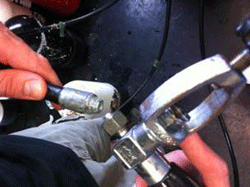Dive cylinder fill whips
Issued: 29 October 2012
Last Updated: 29 October 2012
Purpose
The purpose of this safety alert is to highlight the risks associated with the filling of SCUBA cylinders using a flexible fill hose.
Background
A worker was seriously injured at the premises of a Queensland recreational dive business while filling SCUBA cylinders using a flexible fill hose.
During the filling process, the 'o' ring in the SCUBA cylinder valve failed causing a sudden release of gas. This caused the cylinder to fall over which in turn caused the end fitting of the fill hose to fail. The fill hose then whipped and struck the worker filling the cylinder several times.
Photograph 1: SCUBA cylinder fill whip failure |
Contributing factors
SCUBA cylinders are filled with gas at pressure typically ranging from 200 to 250 atmospheres absolute (ATA). To fill a cylinder, a flexible high pressure hose and attendant fittings are used to decant gas from either bank storage or a compressor. Typically a worker connects and disconnects cylinders and remains at, or near the filling station while the cylinders are filling.
The flexible filling hoses may fail for a range of reasons including:
- inappropriate design or installation
- inappropriate use (e.g. by over pressurisation)
- physical damage (e.g. through corrosion, wear or misuse).
If the hose fails it will typically whip in an uncontrolled manner until depressurised creating a serious risk of death or injury to people within the radius of the hose.
Action required
- The person conducting a business or undertaking (PCBU) that fills SCUBA cylinders should review their filling operations to determine whether risks from the failure of the high pressure fill hose are controlled.
- SCUBA cylinders should be secured against falling during filling operations.
- All components of the cylinder filling system should be specifically designed for the purpose intended and installed by a competent person.
- The PCBU should have operating procedures for filling SCUBA cylinders and ensure all people filling cylinders are appropriately trained.
- The filling area should be isolated from workers and others not involved in the filling procedure.
- Workers should wear appropriate personal protective equipment (consideration should be given to hearing protection, eye protection and foot protection).
Further advice about the safe filling of SCUBA cylinders can be found in Australian Standard AS3848 1999 Filling of Portable Gas Cylinders - Part 2, Filling of portable cylinders for SCUBA and SCBA - safe procedures. Regarding flexible hoses, this standard states:
Where flexible hoses or tubes are used, they should be of a type suitable for high pressure air, have a safety factor of 4 to 1 (burst pressure to system working pressure). Also the assembled hoses and fittings should be tested to 1.5 times maximum system pressure. These flexible hoses and fittings shall be tested annually and marked and tagged with the test data.
WARNING: FLEXIBLE CONNECTIONS MAY WHIP IF DISCONNECTION OCCURS WHILE PRESSURISD. FLEXIBLE CONNECTIONS SHOULD BE SUITABLY RESTRAINED OR RESTRICTED.
Further information
Further information about the safe filling of SCUBA cylinders can be found in section 2.3.6 of the Recreational Diving, Recreational Technical Diving and Snorkelling Code of Practice 2018
Safe filling of portable aluminium alloy cylinders provides further information about filling SCUBA cylinders.
